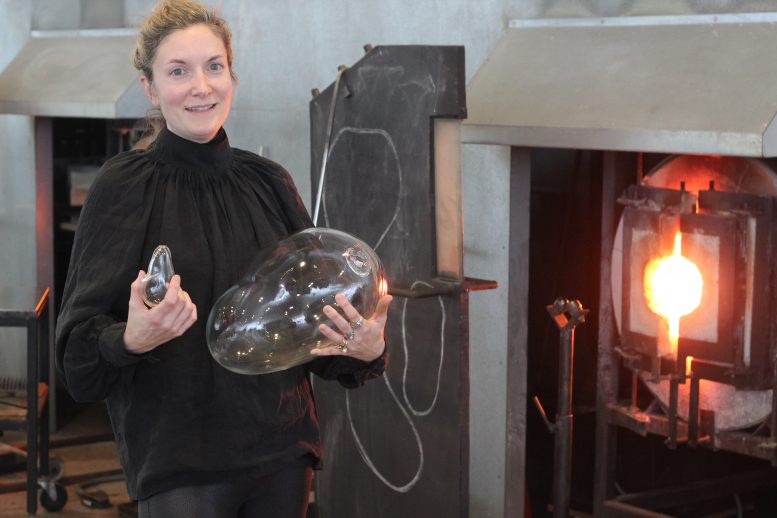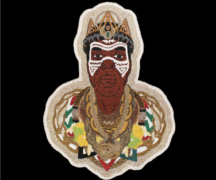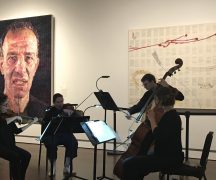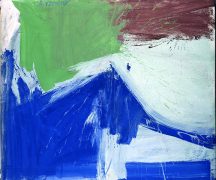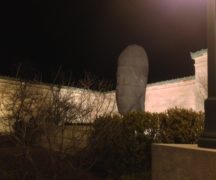By DAVID DUPONT
BG Independent News
Flower artist Rebecca Louise Law isn’t quite done with Toledo yet.
“Community,” her installation at the Toledo Museum of Art, closed Jan. 13 and has now been taken down. The English artist was on hand for the disassembling — the first time she’s been able to participate in the removal of one of her installations.
It’s sad to see the piece, which was in place since June, come down, Law said. “But it’s amazing doing the derig and realizing how precious each of these pieces is, to take it down and pack it up and treasure it as it ought to be treasured to go on to the next place.”
Laws wastes nothing, not even the dust that is the fate of dried flowers.

This was swept up. Working in the museum’s glass hot shop that dust will be encased in four large panels donated by Pilkington.
Law is also using her Guest Artist Pavilion Project residency at the museum to create work for her next installation, scheduled to go up at the Frederik Meijer Garden and Sculpture Park in Grand Rapids, Michigan in September.
Law admitted she’s relying on the skills of the technicians in the hot shop. Her abilities as a glass blower she said are “rubbish,” though she hopes to improve them in the last week of her residency.
She has been more focused on encapsulating flowers, and that got her thinking about how humans are themselves embedded in nature, “the cocoon experience.” So she started considering wombs and “where we come from.”
So she will be creating glass wombs of all sizes, from gestation until just before birth.
Though not a trained glass blower, she inspired by their work.“It’s like watching a dance,” Law said. “It’s like performance art because they are working with such a dangerous material yet they are moving so gracefully and creating such beautiful objects.”
Those will be incorporated into the next show. That show will be more intimate than “Community.”
The viewer will walk into an enclosed space. This idea has been gestating for five years, she said. And she’s made sketch after sketch.
This is not usual for an installation. Law said she creates in a more improvisatory way shaping the work as it is installed.
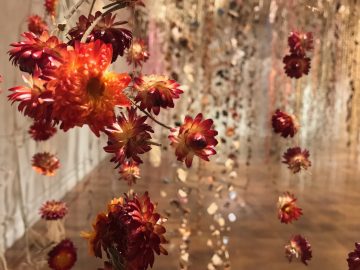
Teaming up with the glass artists is just the most recent in a career of collaborations. She’s worked with photographers and even a taxidermist.
She sources blossoms from a flower farm in Normandy, where they also dry them, achieving the most brilliant colors Law has seen. Those gardeners plan to retire in three years, though they’ve offered to teach Law their craft. “We’ll see,” the artist said. “At the moment, I’m very blessed to have their flowers.”
Most recently she worked with a director to create a short film“The Death of Albine.” (https://deathofalbine.com), which she screened at the talk. It is based on the last chapter of Emile Zola’s novel “The Sinful Priest.”
Law also draws on an army of local people to help in the creation of the installations. Those people and the local flowers incorporated in the installation are what made it work.
The installations are not complete without the people to ground them. In her first installation with hanging garlands, she made a huge ceramic vase as a focal point.
“It looked strange,” Law said. “I realized what grounded the artwork was the person, not the vessel. I needed to forget about the vessel. I started creating natural installations where the human being is the second component of the artwork.”
In another installation, she wanted people to roll around in flower petals. “Nobody would.”
Sharing nature has been central to her work since the beginning. “I’m passionate about pulling the public out into nature and getting away from the 2D screen.”
She grew up in a family of nature lovers — her father’s family has gardened going back six generations and her mother’s family has been painters for as long.
Her parents insisted their children go outside to play.
Law recalled a time when her father brought them to a field of daisies in peak bloom. By tomorrow, he told them, it would all be changed.
Law remembered lying in the middle of the field. “This is just for me,” she thought.
As an artist she said: “I’ve always wanted other people to experience it.”
That started with her painting flowers. But the two-dimensional image didn’t satisfied her. Then on a trip home from art school, she discovered some dahlias her father had cut. She now had flowers instead of paint.
Still those early works were more two-dimensional. The images gradually extended from the wall. She still works encapsulating flowers on a smaller scale, and using the flower dust to create abstract images.
In closing Law urged those in attendance to continue to treasure what they have in the Toledo Museum. “The community here is incredibly special,” she said. “My family has been very touched by it.”
Reflecting on “Community,” Law said: “I don’t know if I’ll ever make one as detailed. … The scale of this was immense. I’m very proud of what we achieved.”

